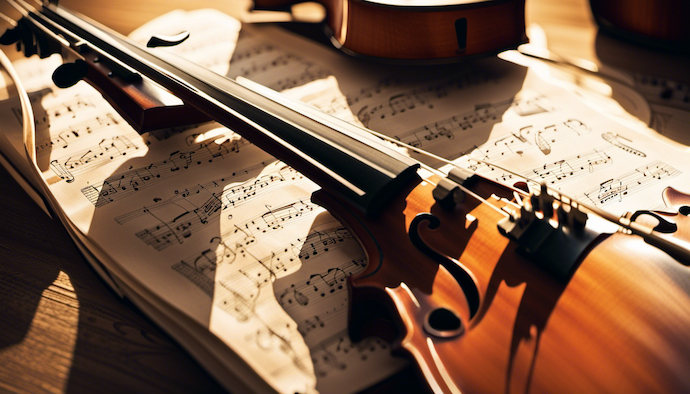In the world of classical music, certain instruments have always held a more prominent and celebrated place than others. The violin, with its soaring melodies and virtuosic performances, is often the star of the show. The cello, with its rich and deep tones, is frequently featured in solo and chamber music.
But what about the viola? This often-overlooked member of the string family possesses a unique and understated greatness that deserves recognition. We will explore the history, versatility, and unique qualities of the viola that make it a truly remarkable instrument, so by the end of the article, you might just consider learning to play it.
The History of the Viola

The history of the viola can be traced back to the early days of stringed instruments. Its roots can be found in the viol family, which was popular during the Renaissance and Baroque periods. The viola da gamba, a predecessor of the modern viola, was played vertically and had frets, giving it a distinct timbre and playing technique. However, the range of refined and melodious violas available nowadays, which are played with a bow and horizontally on the shoulder, emerged as a unique instrument in the 17th century.
Mozart’s Affinity for the Viola
One of the most notable early advocates for the viola instrument was none other than Wolfgang Amadeus Mozart. Mozart, a musical genius renowned for his compositions for various instruments and ensembles, had a special affinity for the viola. He recognized the instrument’s ability to bridge the gap between the higher-pitched violin and the lower-pitched cello, creating a harmonious and balanced sound in string quartets. In his six-string quintets, Mozart often added a second viola to the traditional string quartet ensemble, showcasing its ability to enrich the texture of the music.
Versatile Instrument
The versatility of the viola is a key factor in its greatness. While it is often overshadowed by its counterparts, the violin and cello, the viola’s unique voice offers a distinctive colour to any musical composition. Its mid-range tones, closest to the human voice, can be both warm and expressive, making it a versatile choice for solo, chamber, and orchestral music. It is this versatility that allows violas to shine in a wide range of musical genres, from classical to contemporary, jazz to folk.
Essential in the Orchestra
In classical music, the viola is an essential member of the orchestra. Its voice fills the middle range of the string section, providing a vital link between the higher-pitched violins and the lower-pitched cellos and double basses. Orchestral composers have long recognized the value of the viola’s timbre and have composed beautiful and challenging parts for it. Works like Richard Strauss’s “Don Quixote” and Dmitri Shostakovich’s Symphony No. 10 feature prominent and emotionally charged viola solos that showcase the instrument’s expressive capabilities.
A Star in Chamber Music
In addition to its role in the orchestra, the viola is a star in the world of chamber music. String quartets, quintets, and other chamber ensembles frequently include the viola, relying on its ability to provide depth and complexity to the music. Composers like Johannes Brahms, Antonín Dvořák, and Béla Bartók have composed masterpieces that highlight the viola’s central role in chamber music, allowing it to shine in intimate settings.
A Surprise in Jazz and Folk Music
While it excels in classical and orchestral settings, it has also found its place in other musical genres. In the world of jazz, the viola has been explored by innovative musicians who appreciate its unique tonal qualities. It can add a distinctive voice to jazz ensembles, creating a fresh and unexpected sound. In folk music traditions around the world, the viola has been used to convey the soulful melodies of different cultures, showcasing its ability to connect with diverse musical styles.Unique Qualities
The viola’s understated greatness also lies in its unique qualities as an instrument. It possesses a warm and velvety tone that is distinct from the brighter sound of the violin and the deeper resonance of the cello. This quality makes the viola well-suited for conveying a wide range of emotions, from melancholy and introspection to warmth and nostalgia. Its rich, sonorous sound can tug at the heartstrings of the listener, evoking powerful emotions that resonate deeply.
Why Should I Learn Viola?

The physicality of playing the viola sets it apart. Its slightly larger size and longer string length require a different technique and physicality compared to the violin. Viola players, often called violists, must navigate the unique challenges of the instrument, such as wider finger spacing and greater bow control. This demands a high level of skill and dedication, which adds to the instrument’s allure. Many violists embrace these challenges, finding fulfilment in mastering an instrument that requires both technical prowess and musical sensitivity.
That said, the number of people playing this instrument is quite small, so if you buy a viola and master it, you will literally be one in a million. With orchestras constantly on the lookout for a violist, you will have plenty of career opportunities.
Make sure to get a corresponding instrumental case to maintain the item’s quality and longevity. These are necessary to guard your viola against the elements, particularly when you have outdoor performances and need to move around. Having a high-quality case also makes it easier to attend rehearsals as you only need to carry one item instead of multiple, which can be quite cumbersome.
Inspiration for Composers
Beyond its musical capabilities, the viola has played a significant role in the lives of many musicians and composers. It has been the source of inspiration for countless works, with composers often drawing on the instrument’s character and expressiveness.
For example, Dmitri Shostakovich, a renowned Russian composer, wrote his Viola Sonata, Op. 147, during a period of physical and emotional hardship. The sombre and introspective nature of the piece reflects the unique qualities of the viola and its ability to convey deep emotion.
A New Breath of Life
In recent years, the viola has experienced a resurgence in popularity. A new generation of talented violists and composers is pushing the boundaries of what the instrument can achieve. Contemporary composers are writing exciting and innovative music for the viola, exploring new techniques and sounds that highlight its unique qualities. This resurgence is also driven by the desire for diversity and inclusivity in classical music, as the viola provides a platform for underrepresented voices in the field.
Finishing Thoughts
The greatness of the viola lies in its rich history, versatility, unique qualities, and the passion of those who play and compose for it. This often-overlooked instrument has the power to evoke deep emotions, connect with audiences across genres, and enrich the world of music. As we celebrate the viola’s understated greatness, let us recognize its enduring legacy and the dedicated individuals who continue to champion its cause. The viola may be a hidden gem, but its brilliance shines brightly in the world of music.





















